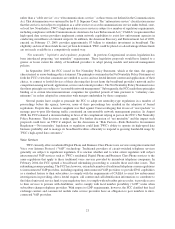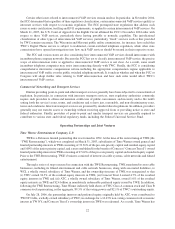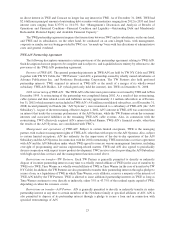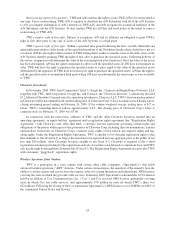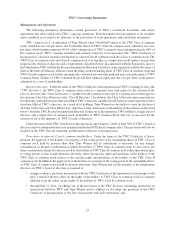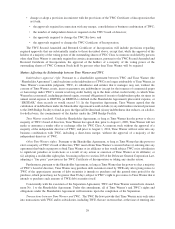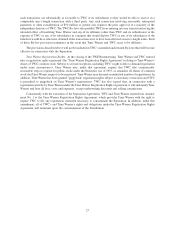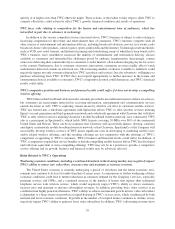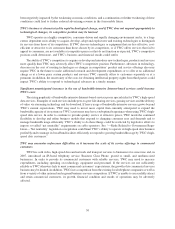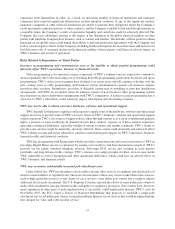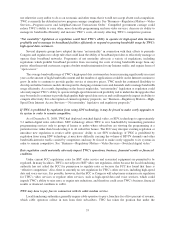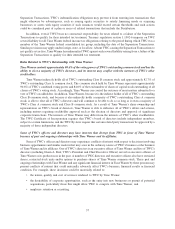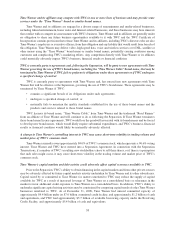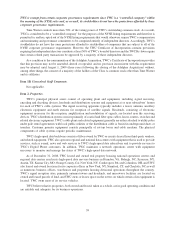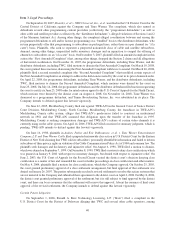Time Warner Cable 2008 Annual Report Download - page 40
Download and view the complete annual report
Please find page 40 of the 2008 Time Warner Cable annual report below. You can navigate through the pages in the report by either clicking on the pages listed below, or by using the keyword search tool below to find specific information within the annual report.been negatively impacted by the weakening economic conditions, and a continuation or further weakening of these
conditions could lead to further reduced advertising revenue in the foreseeable future.
TWC’s business is characterized by rapid technological change, and if TWC does not respond appropriately to
technological changes, its competitive position may be harmed.
TWC operates in a highly competitive, consumer-driven and rapidly changing environment and is, to a large
extent, dependent on its ability to acquire, develop, adopt and exploit new and existing technologies to distinguish
its services from those of its competitors. If TWC chooses technologies or equipment that are less effective, cost-
efficient or attractive to its customers than those chosen by its competitors, or if TWC offers services that fail to
appeal to consumers, are not available at competitive prices or that do not function as expected, TWC’s competitive
position could deteriorate, and TWC’s business and financial results could suffer.
The ability of TWC’s competitors to acquire or develop and introduce new technologies, products and services
more quickly than TWC may adversely affect TWC’s competitive position. Furthermore, advances in technology,
decreases in the cost of existing technologies or changes in competitors’ product and service offerings also may
require TWC in the future to make additional research and development expenditures or to offer at no additional
charge or at a lower price certain products and services TWC currently offers to customers separately or at a
premium. In addition, the uncertainty of the costs for obtaining intellectual property rights from third parties could
impact TWC’s ability to respond to technological advances in a timely manner.
Significant unanticipated increases in the use of bandwidth-intensive Internet-based services could increase
TWC’s costs.
The rising popularity of bandwidth-intensive Internet-based services poses special risks for TWC’s high-speed
data services. Examples of such services include peer-to-peer file sharing services, gaming services and the delivery
of video via streaming technology and by download. If heavy usage of bandwidth-intensive services grows beyond
TWC’s current expectations, TWC may need to invest more capital than currently anticipated to expand the
bandwidth capacity of its systems or TWC’s customers may have a suboptimal experience when using TWC’s high-
speed data service. In order to continue to provide quality service at attractive prices, TWC needs the continued
flexibility to develop and refine business models that respond to changing consumer uses and demands and to
manage bandwidth usage efficiently. TWC’s ability to do these things could be restricted by legislative efforts to
impose so-called “net neutrality” requirements on cable operators. See “—Risks Related to Government Regu-
lation—‘Net neutrality’ legislation or regulation could limit TWC’s ability to operate its high-speed data business
profitably and to manage its broadband facilities efficiently to respond to growing bandwidth usage by TWC’s high-
speed data customers.”
TWC may encounter unforeseen difficulties as it increases the scale of its service offerings to commercial
customers.
TWC has sold video, high-speed data and network and transport services to businesses for some time and, in
2007, introduced an IP-based telephony service, Business Class Phone, geared to small- and medium-sized
businesses. In order to provide its commercial customers with reliable services, TWC may need to increase
expenditures, including spending on technology, equipment and personnel. If the services are not sufficiently
reliable or TWC otherwise fails to meet commercial customers’ expectations, the growth of its commercial services
business may be limited. In addition, TWC faces competition from the existing local telephone companies as well as
from a variety of other national and regional business services competitors. If TWC is unable to successfully attract
and retain commercial customers, its growth, financial condition and results of operations may be adversely
affected.
30



